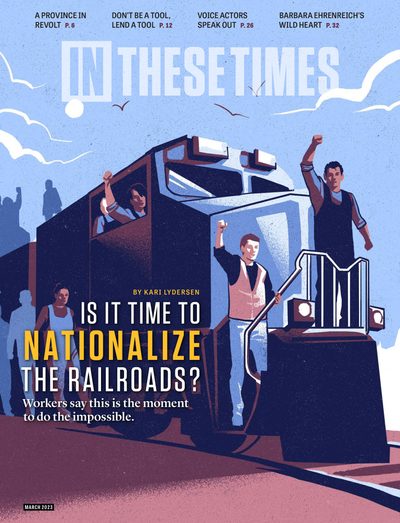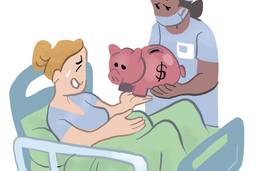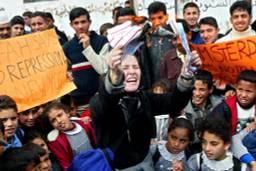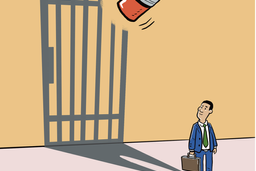The Cracks in the Crystal Ball
Existential crises in the Bread Basket of Europe.
In These Times Editors
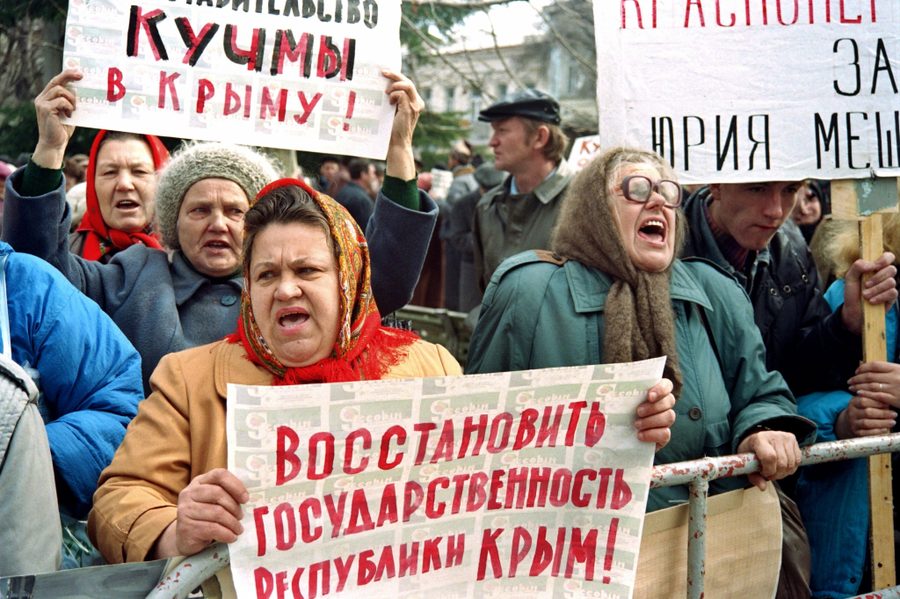
Paul Hockenos wrote “The Balkanization of Ukraine” in 1994, three years after Ukraine declared its independence from the dissolving USSR. That independence was followed by economic collapse: Ukraine’s GDP fell more than 50% in the early 1990s, and its dependence on trade with Russia and former Soviet states led to tangled economic policies and hyperinflation. The escalating crisis stirred familiar resentment in Eastern Ukraine, where the separatist movement in Crimea was buoyed by Russian efforts to maintain a military base in Sevastopol.
As Hockenos wrote, the “catastrophic state of the economy has fueled disillusionment among Russians who are wondering whether they might not be better off with Mother Russia,” as the Russian economy was much better off and ethnic nationalism and financial collapse had stressed Ukraine to its limit. Free-market shock therapists from the United States could worsen the situation beyond repair, Hockenos warned, but just months after this article’s publication, Ukraine elected Leonid Kuchma, a new president with intentions to rapidly implement a free-market economy. Hockenos’ prognostications remain relevant as the war in Ukraine nears its first anniversary.
In 1994, Paul Hockenos wrote:
A conflict with enormous potential repercussions for Europe is brewing between Ukraine and Russia. The confrontation already bears striking resemblance to the early phases of the Balkan wars, with the notable exception that none of the factions in former Yugoslavia had nuclear weapons. But disintegration in Ukraine is no more inevitable than was war in Bosnia, should the world community act decisively before words turn to violence.
There are two parallel sources of tension in Ukraine: the growing unhappiness of the Russian minority, and the geopolitical rivalry between Kiev and Moscow. Should both of these conflicts continue to escalate and converge with one another, Ukraine could well break apart, with Russia making territorial bids on its southern and eastern regions.
Although ethnic Russians comprise 22 percent of Ukraine’s total population of 52 million, they are not a typical East European “ethnic minority.” Until independence in 1991, Ukrainians were considered “little Russians,” and even today many Ukrainians east of Kiev use Russian as their mother tongue. In the wake of independence, Kiev went out of its way to grant the Russians far-reaching cultural rights. Most ethnic Russians backed Ukrainian statehood at the time.
But economic implosion and ethnic nationalism have combined to test the young Ukrainian state. In the Russian heartlands of the eastern Donbas and Crimea in the south, the catastrophic state of the economy has fueled disillusionment among Russians who are wondering whether they might not be better off with Mother Russia after all. Four-digit inflation and an average wage of $20 a month spell an economic crisis far worse than in Russia.
Nor has Kiev’s “Ukrainianization” campaign endeared the Russians to its cause. The response has been ever louder calls from the Russians for political and regional autonomy. As anywhere in Eastern Europe, in the western Ukraine these demands smack of separatism, a first move toward linking up with Russia.
For someone who experienced the onset of the Serb-Croat conflict in 1990, the scenario and mechanisms at work sound all too familiar. January elections in the 70-percent Russian Crimea put a Russian nationalist into office who began his campaign promising secession from Ukraine. Although he back-pedaled after a furious outcry from the Ukrainian parliament, the Crimean Russians plan a popular referendum this spring on joining the ruble zone. The vote came on the heels of elections in neighboring Belarus, where the victorious old-school communists immediately put plans in motion to establish a monetary union with Russia, which could lead to reunification.
Russia has never accepted Ukrainian possession of the Crimea, which was only transferred to its control in 1954. And even for Russians content in Ukraine, Russia exerts a certain pull. Whereas western Ukraine sees itself as part of eastern Europe, the eastern Russians identify with Russia. A split like this within a new state searching for its bearings in Europe presents the Kiev political elite with a balancing act that it cannot maintain for long.
Since the breakup of the Soviet Union, the major sources of contention between Kiev and Moscow have been the 1,600 nuclear warheads on Ukrainian territory and the Black Sea fleet in Ukrainian waters. As the legal successor to the Soviet Union, Russia claims the nuke missiles and navy as its own. Ukraine has wavered over its relationship to the nukes, although it has never had operational control of the missiles. The firing code is in Moscow and will probably stay there, whatever Ukrainian ultra-nationalists may say.
Under heavy international pressure, Ukrainian President Leonid Kravchuk finally agreed early this year to transfer all of the warheads to Russia for disassembly. The decision provoked cries of treason in Kiev. The warheads and the Black Sea fleet are Ukraine’s only trump cards, and without them they have nothing to ward off Russia or interest the West. Although signed away, the missiles are still in Ukraine, and will be dismantled very slowly over a period of seven years, as Kravchuk insisted. Until then, Ukrainian scientists will remain hard at work trying to crack the firing codes.
Despite repeated Russian assurances of the inviolability of Ukraine’s borders, Kiev has ample reason to question its northern neighbors’ intentions. The Russian ultra-nationalist camp, led by Vladimir Zhirinovsky, sees Ukraine as an essential part of a greater Russian empire. But even discounting extremists like Zhirinovsky, there exists wide-scale agreement within Russian politics over Moscow’s special interest in its “near abroad.” Backed by liberals, Communists and nationalists alike, Yeltsin has staked out spheres of Russian influence in the former Soviet Union, which include the Baltics, Belarus, Ukraine and Moldova in the west, the Caucasus in the south, and the Central Asian countries in the east. Although outside the near abroad, the former Warsaw Pact Central Europeans also have a special place in Russian interests, as Moscow made clear with its warning that NATO not expand a single kilometer eastward. By heeding Yeltsin, the West has essentially condoned future Russian influence there.
There is actually little Ukraine can do to hinder Russian infringement upon its sovereignty. At any moment, Moscow could stir Russian nationalism in east Ukraine as effortlessly as Belgrade did Serb nationalism in Croatia or Bosnia. Ukraine remains economically dependent on Russia as its largest source of trade, its greatest creditor and supplier of its energy needs. (See In These Times, Oct. 18, 1993.) Were Russia to isolate Ukraine, the Ukrainian economy would collapse in no time.
The economy remains key to Ukraine’s stability. U.S. and international policy-makers are pushing Kravchuk to proceed more radically with reform, to apply the same shock-therapy recipe that has had such disastrous consequences elsewhere. International Monetary Fund-style austerity measures and full-speed privatization could prove a fatal blow to Ukraine, hitting the eastern rust belt first and hardest.
Ukraine needs substantial aid and loans for gradual restructuring, trade opportunities with the West, and binding security guarantees from both Russia and NATO. The international community cannot afford to make the same mistake with Russia that it did with Serbia, appeasing an expansionist power at the expense of its neighbors. The Eastern Europeans will not tolerate restrictions on their newly won sovereignty, nor should they. And, like the Bosnians, they will fight to defend it.
